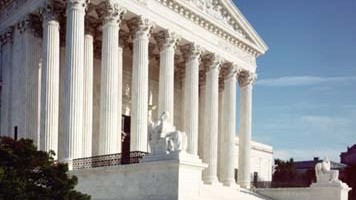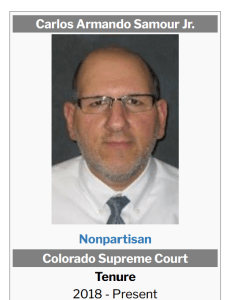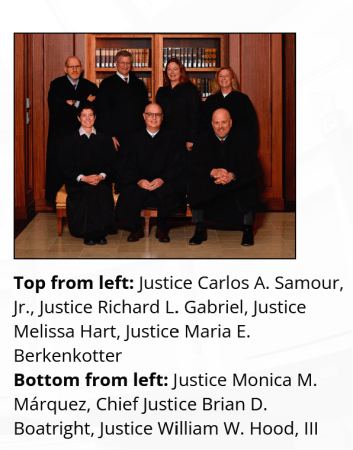by Joseph DeMaio, ©2023
(Dec. 22, 2023) — INTRODUCTION
Well, faithful P&E readers, buckle up: the Colorado Supreme Court, consisting of seven judges – all appointed by Democrat Colorado governors – has issued an opinion in a case captioned Anderson v. Griswold. The decision purports to bar President Trump from the Colorado primary ballot, allegedly because he engaged in “insurrection” or “rebellion” against the United States Constitution, an argument based – erroneously – on a painfully twisted and result-oriented interpretation of Clause 3 of the 14th Amendment, the “insurrection-rebellion disqualification” clause, hereafter, for brevity, “Clause 3.”
Although the decision has already been discussed here at The P&E in a post charitably labeling it as a “stupid stunt,” your humble servant proposes here to take readers on a slightly deeper dive into just how ill-reasoned the majority decision really is. This task is made easier by simply reading the dissenting opinions.
The per curiam (“for the court,” unsigned) 127-page majority opinion by four judges – none of whom had the courage or conviction to take credit for its authorship – is followed by three signed dissenting opinions by Chief Justice Brian Boatright (11 pp.), Justice Carlos Samour, Jr. (43 pp.) and Justice Maria Berkenkotter (25 pp.), for an aggregate combined 79-pages of dissent.
Again, none of the remaining four “per curiam” judges – Richard Gabriel, Melissa Hart, Monica Márquez or William Hood, III – showed the bravery to take credit, even in part, for the majority opinion. Indeed, after reading the dissents, one is tempted to speculate on whether the “for the court” opinion was instead actually cobbled together by a Democrat AI computer squirreled away in some broom closet of a leftist Denver law firm.
While the vast bulk of the majority ruling addresses the issues in the context of the application of Colorado’s own particular election laws, its foundational thesis for the “disqualification” of President Trump – an extra-judicial, due-process-lacking conclusion that he violated Clause 3 of the 14th Amendment on January 6, 2021 – is eviscerated by all of the dissenting opinions, each articulating separate, but related reasons for dissenting.
Spoiler alert: the three signed dissenting opinions are far better reasoned and, moreover, free of the blatantly political and unvarnished anti-Trump patina of the majority opinion. And while any of the three dissenting opinions compels the logical rejection of the majority opinion, Justice Carlos Samour, Jr.’s dissent and its analysis – rejecting the majority’s ipse dixit conclusion that the 14th Amendment provision in question is “self-executing” – completely eradicates any hint of judicial gravitas skulking somewhere in the majority decision.
And while all of the dissenting Justices hold their law degrees from the Sturm College of Law at the University of Denver, the “per curiam” judges attended Yale (Márquez); the University of Virginia (Hood); the University of Pennsylvania (Gabriel); and, of course, Hah-vahdh (Hart). Interesting…, no?
Still, all of the Justices are Democrats, proving that every now and then, even a Democrat judge – i.e., the three dissenters – can see through and poke holes in a smokescreen.
The decision (characterized as a “ruling” in the opinion) has by the court itself been stayed – legalese for “put on hold” – until January 4, 2024 to allow for an appeal to the United States Supreme Court (“USSC”). If an appeal is taken – and by the time you read this, a notice of appeal may have already been filed – the likelihood is that President Trump’s name will remain on the Colorado primary ballot, as that was part of the decision of the lower Colorado trial court, a ruling not reversed by the “per curiam” majority.
Your humble servant has read all 206 pages of the majority and dissenting opinions, footnotes and all. Time and inclination permitting, P&E readers are encouraged to do the same, as that will sear in the mind just how badly reasoned the majority ruling really is.

Perhaps it is the mile-high altitude and lower concentration of oxygen in Denver that has affected Judges Gabriel, Hart, Márquez and Hood, although oxygen deprivation does not seemed to have adversely affected Judges Boatright, Samour and Berkenkotter. Maybe it is because all three dissenters, having attended the Sturm College of Law in Denver, have become acclimated to the thin air.
As an aside, your humble servant claims that he has a few relevant things to say about the “natural born Citizen” (“nbC”) issue under Art. 2, § 1, Cl. 5 of the Constitution, which issue, interestingly, is even mentioned in both the majority and dissenting opinions in Anderson. But he is far less versed on Clause 3 of the 14th Amendment.
On the other hand, he views as a far more authoritative voice on Clause 3 that of George Washington University Law Professor Jonathan Turley. Professor Turley has penned two extraordinarily good and timely articles on the Colorado majority opinion – which he correctly labels as “insidious” – which readers should also consume here.
He posits that not only should the Supreme Court reverse the Colorado majority opinion, it has the opportunity to return some sanity to the controversy – and unity to the badly fractured body politic – by reversing in a unanimous 9-0 decision. That is a tall order, but not entirely impossible. However, with jurists like Justices Sotomayor, Kagan and Brown Jackson on the Court, do not hold your breath for such a result. Their disdain for President Trump and the “MAGA” movement is almost as deep as former President H.W. Bush’s hatred of broccoli.

That said, however, at the end of the day there may be a simple way that this unconstitutional “mile-high” anomaly might be “handled,” not to be confused with “resolved.” While it would be a clear “dodge” by the Court to fail to directly address the 14th Amendment issues and produce a binding decision – an “avoidance” or “punting” which the Court has all too often taken in the past – the Court might consider a remand back to the lower court(s) to re-examine various of the “myriad legal questions” which are not yet, in the Court’s opinion, “adequately addressed” and require “additional briefing and analysis.”
Because of the “stay order” currently in place, preserving President Trump’s name on the Colorado ballot, although the matter is not yet finally resolved, the “status quo” would result in President Trump’s name remaining on the Colorado primary ballot unless and until the Supreme Court were to rule otherwise. Whether that would be true for other “blue” states such as California remains to be seen.
Moreover, unless another post-remand appeal and final decision of the USSC were forthcoming before the general election in November, 2024, his name would likely remain on the states’ general election ballots, too. And when the results of that general election (unless otherwise somehow gummed up as with Bush v. Gore back in 2000) were known, the Court would most likely declare the present “14th Amendment disqualification” dispute moot, resulting in its dismissal.

Bada bing, bada boom: just a different way of “evading” the issue, not unlike the Court’s tactic of “evading” the presidential “natural born Citizen” issue.
The fallout from the Colorado decision will likely continue until either November 5, 2024 or the Supreme Court renders a binding decision which would apply to all of the states, red, blue and plaid. These species of frivolous actions were, back in the day, once called “chicken $*!%.” Yet such is the legacy of today’s radical, progressive Democrats’ intent on wrecking the nation in concert with Brandon the Goof…, and the millions of illegal aliens he has imported.
Interested? Read on.
ANALYSIS
To begin with, this offering is long…, probably too long. But the issues are complex and important. Stated otherwise, readers may want to keep a supply of their favorite caffeinated beverage close by.
Also, as your humble servant has frequently noted, words are important. Precision in language is critical to the conveyance of rational thought. They are the means whereby sentient beings communicate intelligently with one another. Or, as Mark Twain noted on the importance of selecting the “right” as opposed to the “not right” word, “[T]he difference between the almost right word and the right word is really a large matter – it’s the difference between the lightning bug and the lightning.”
Lamentably, the majority per curiam opinion in the Anderson case glosses over that critical distinction and protocol as if it did not even exist, a major deficit in the reasoning of the majority, as discussed hereafter.
Reduced to its essence, the majority opinion concludes that President Trump violated Clause 3 of the 14th Amendment, purportedly, because he engaged in an “insurrection” or a “rebellion” against the Constitution by exhorting his supporters to protest the results of the 2020 general election. Diving into each of the myriad arguments of the majority opinion would put P&E readers to sleep, so only the more inane and legally unsupportable ones will be addressed.
As a threshold matter, while the dissenting opinions of Chief Justice Boatright and Justice Berkenkotter are both good, the dissent of Justice Carlos Samour, Jr. is excellent, as unlike the other dissents, it peels back the linguistically lazy and misleading assertions of the per curiam onion…, then eats them.
With any kind of luck, the Samour dissent could serve as a template for a Supreme Court opinion reversing the “insidious” ruling of the Colorado Supreme Court majority. Accordingly, most of the balance of this offering will focus on Justice Samour’s dissent and insightful critique of the majority opinion.

To begin with, Clause 3 of the 14th Amendment characterizes the “breach” as to which preclusion from holding office will apply as being a “disability” rather than a “disqualification” or event of “ineligibility.” Indeed, the amendment itself states that “Congress may by a vote of two-thirds of each House, remove such disability.” (Emphasis added) Congress does not have the power or authority to declare as constitutionally “eligible” a candidate who is constitutionally “ineligible.”
And calling a candidate “unqualified” for or “disqualified” from a particular office has nothing to do with whether he/she is “eligible” or “ineligible” to the same. And if Congress cannot do that, neither can a state Supreme Court. Full stop.
Furthermore, Clause 3’s use of the term “such” in describing the “disability” subject to congressional removal employs it as referring back to the activity “engaged in insurrection or rebellion against the same.” (Emphasis added). Stated otherwise, the antecedent of the words “such disability” refers back to the potential “breach” consisting of engaging in “insurrection or rebellion against the same.” In this sense, “the same” in turn refers back to “the Constitution of the United States.” It does not refer back to the Congress; it does not refer back to the judiciary; it does not refer back to anything other than the Constitution.
While it remains an open question as to whether the demonstrators – others prefer the term “rioters” – involved in the January 6, 2021 events constituted persons engaged in a protest over how the electoral votes regarding the 2020 general election were to be tallied – a function assigned to the Vice-President and the members of the Electoral College – it is a giant leap to conclude that those actions by the folks who entered the Capitol building constituted an insurrection or rebellion against the Constitution itself.
It is an even greater leap to posit that President Trump, in urging his supporters to “peacefully and patriotically march to the Capitol” to make their voices heard was, instead, exhorting them to rebel against the Constitution and engage in a violent “insurrection” against something other than the Constitution.
Judge Samour’s dissent asserts that the “shortcut proceedings” resulting in the decision to bar President Trump from the Colorado primary ballot “flies in the face of the due process doctrine.” He is too kind: the proceedings spat in the face of due process…, and then smugly claimed that despite traveling in “uncharted territory” (per curiam opinion at 6), the decision is compelled. Judge Samour’s dissent incinerates that claim.

That said, Judge Samour’s dissent might be seen by U.S. Attorney General Merrick Garland as an invitation to indict President Trump criminally under 18 USC § 2383, discussed hereafter. If that were to happen, there would likely be rioting in the streets. The Democrats are evil and intent on destroying America. What better way to pursue that goal than to initiate – in deep, deep blue Washington, DC – a criminal case against the man who, instead of wanting to destroy America, simply wants to “Make America Great Again?”
Turning specifically to Justice Samour’s dissent, he decries the complete denial of President Trump’s due process rights, stating (Samour dissent at 1):
“The decision to bar former President Donald J. Trump (“President Trump”) – by all accounts the current leading Republican presidential candidate (and reportedly the current leading overall presidential candidate)—from Colorado’s presidential primary ballot flies in the face of the due process doctrine.” (Emphasis added)
To reiterate, Justice Samour is too charitable: the decision spits on, then kicks to the curb, even the most modest of President Trump’s due process rights, including the right of a jury trial, the right to subpoena and depose witnesses and the right to enough time to prepare for the kangaroo court spectacle to which he and his lawyers were subjected.
On a more substantive matter, chief among the majority’s arguments is the ipse dixit – “it is so because I say it is so” – claim that Clause 3 is “self-executing,” meaning that its enforcement is not dependent on separate congressional legislation to trigger its operation. That claim is advanced at pp. 49-61 of the per curiam opinion.
Thus, so goes the argument, each individual state can cobble together what it believes will constitute its own unique conditions to support a cause of action to implement Clause 3 to bar any Tom, Dick, Harry, Diane, Katie or Blanche from the ballot for nearly any reason the state declares to be an event of “insurrection” or “rebellion.” This cannot be what the authors of the 14th Amendment intended.
Dissenting Justice Samour demolishes that theory thusly (Samour dissent at 3):

“The majority repeatedly uses “self-executing” to describe Section Three, but then reasons that this part of the Fourteenth Amendment is enforceable in Colorado only because of the procedures our legislature has enacted as part of the state’s Election Code. This strikes me as an oxymoron. If a constitutional provision is truly self-executing, it needs no legislation to be enforced.” (Emphasis added)
Justice Samour then gives an example of congressional legislation which does implement Clause 3: 18 U.S.C. § 2383. That federal statute specifically criminalizes acts committed in violation of Clause 3 – after a full trial held in compliance with due process requirements (lacking here) and only if convicted – and which statute, he then notes, has never been asserted against President Trump. He states (Samour dissent at 4):
“Significantly, there is a federal statute that specifically criminalizes insurrection and requires that anyone convicted of engaging in such conduct be fined or imprisoned and be disqualified from holding public office. See 18 U.S.C. § 2383. If any federal legislation arguably enables the enforcement of Section Three, it’s section 2383. True, President Trump has not been charged under that statute, so it is not before us. But the point is that this is the only federal legislation in existence at this time to potentially enforce Section Three. Had President Trump been charged under section 2383, he would have received the full panoply of constitutional rights that all defendants are afforded in criminal cases. More to the point for our purposes, had he been so charged, I wouldn’t be writing separately to call attention to the substandard due process of law he received in these abbreviated Election Code proceedings.” (Emphasis added)
The fact that President Trump has not been indicted by the most anti-Trump attorney in the Brandon-weaponized “Department of Just-Us” – Attorney General Merrick Garland – should speak volumes about whether Monsieur Garland thinks Mr. Trump violated Clause 3, even in deep, deep blue Washington, DC. One would think with the stakes so high, Garland would have charged Mr. Trump by now…, yet he has not. Perhaps because as to that claim, like Peter Strzok, “there’s no big there there.”
Undeterred, four oxygen-deprived justices of the Colorado Supreme Court have instead concluded that President Trump was an insurrectionist on January 6, 2021 and that the Colorado Secretary of State would herself be violating Colorado law if she placed his name on the primary ballot there because he has been declared by the court itself to be – ipse dixit –“disqualified.” Ludicrous.
Again referring to Justice Samour’s dissent and criticizing the majority for ignoring the most basic of President Trump’s due process rights, he states (Samour dissent at 38):
“The result was a proceeding that was neither the ‘summary proceeding’ envisioned by … [Colorado Election Code law] nor a full-blown trial; rather, it was a procedural Frankenstein created by stitching together fragments from … [Colorado Election Code law] and remnants of traditional civil trial practice.” (Emphasis added)
Justice Samour’s “Frankenstein” analogy is, once again, too kind: the per curiam ruling is a combination Frankenstein-Dracula-ManBearPig judicial mutant that will likely go down in the history of stupid decisions on a par with Scott v. Sandford (the “Dred Scott” case).
Finally, summing up his disdain for the majority ruling, he states (Samour dissent at 39-40):
“I have been involved in the justice system for thirty-three years now, and what took place here doesn’t resemble anything I’ve seen in a courtroom. In my experience, in our adversarial system of justice, parties are always allowed to conduct discovery, subpoena documents and compel witnesses, and adequately prepare for trial, and experts are never permitted to usurp the role of the judge by opining on how the law should be interpreted and applied. The majority tries to excuse the due process shortcomings I have discussed by noting that … [Colorado Election Code law] proceedings ‘move quickly out of necessity’ because ‘[l]ooming elections trigger a cascade of deadlines . . . that cannot accommodate protracted litigation schedules, particularly when the dispute concerns a candidate’s access to the ballot.’ Maj. op. ¶ 81.
“But that’s exactly my point. The necessarily expedited nature of … [Colorado Election Code law] proceedings is precisely why the Electors should not have been allowed to piggyback a Section Three claim – an admittedly complex constitutional claim – on their Election Code claim in the first place. In any event, the majority’s acknowledgement that … [Colorado Election Code law] proceedings ‘cannot accommodate protracted litigation’ seems to directly contradict its determination that the Election Code endowed the district court with the ‘flexibility’ to adequately accommodate the needs of this complex litigation. Id. at ¶¶ 81, 85. [footnote omitted]. The majority can’t have its cake and eat it too.” (Emphasis added)
CONCLUSION
This post is already too long, so your servant will stop here. However, with any luck, faithful P&E readers will now have a better understanding of just how flawed the Colorado Supreme Court per curiam majority decision is and why it must be reversed by the Supreme Court. If any additional reasons are needed, then a page-by-page, footnote-by-footnote reading of the majority ruling and the three dissents should be undertaken.
But trust your humble servant: when three Democrat justices of the Colorado Supreme Court split so clearly from their majority colleagues, you know something is very wrong with the main decision.
Whether or not the Supreme Court will – as urged by Jonathan Turley at the beginning of this post – “do the right thing” and reverse with a unanimous 9-0 ruling remains to be seen. If past is prologue and the Court’s reluctance to confront the “natural born Citizen” (“nbC”) issue by “evading” it is any indicator, then the likelihood of a remand to give the Court time to “kick the Clause 3 can” farther down the road might materialize.
And whether other blue states like California determine to adopt the same “chicken $*!%” approach to bar Orange Man Bad from their respective ballots still remains an unanswered question.
Is this a great country or what? Stay tuned, as this issue is sure to get even more interesting very quickly.






